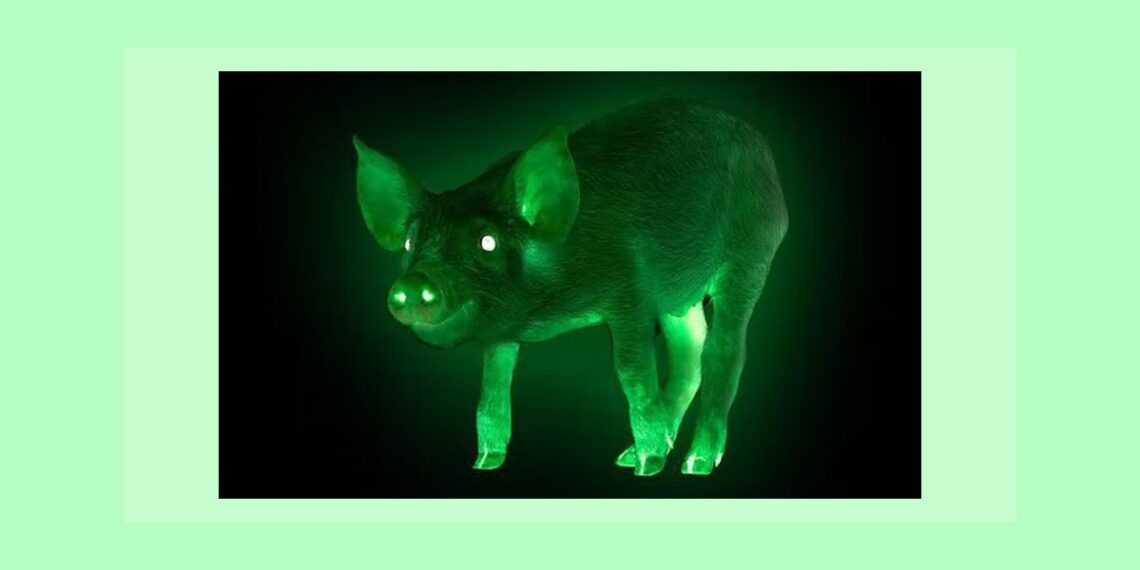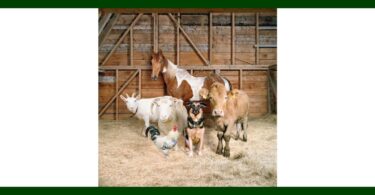Are you all ready to get out of your comfortable chairs? Follow me to a cold and poorly lit stable to treat a patient.
It is winter. The outside temperature is around freezing point. Chestnut, an Old Gloucestershire pig of 3 years produced a litter of seven piglets two days prior to the phone call for help. (Old Gloucestershire is a breed of white pigs with large dark spots.)
This is her 3rd litter. She was a little slow in giving birth compared to last time but all went fine. The piglets are doing well but mum does not want to eat or drink, not even a drop, and is hardly interested in her offspring.
When the owner rings me, I am out in my car and stop along the roadside to ask for a few more details. There is no fever, no signs of constipation, no signs of metritis, Chestnut is not grumpy when approached, not even when the piglets are touched (normally sows play up if you touch their piglets) and she feels normally warm all over, even her ears (they usually are cold or occasionally hot when pigs are unwell).
Conclusion, there does not appear to be an infectious process. (It is common for sows to develop a womb infection or mammary infection after giving birth. This will be accompanied by loss of appetite but also constipation and some signs of illness. In this case there were no other signs of illness apart from the lack of appetite and interest.)
I am thinking: not drinking at all, slowness during delivery, ailments after parturition, and I advise to use Nux Moschata 30C, three times per day for 2 days and to keep in touch.
The next day, the client tells me that Chestnut has eaten and drunk a little and seems to be more responsive. The remedy is continued but the 2nd day it becomes clear that the response is not sufficient. It is time to get my wellies on (rubber boots in the UK) and drive down to see Chestnut.
Clinically there is nothing abnormal about Chestnut. The piglets are doing ok regardless the fact that their mum does not have a lot of milk. They seem content enough. Normally one would expect that when there is a lack of milk, piglets become restless and noisy. In other cases, when something is desperately wrong with a sow, the piglets soon become ill or die. In this case the piglets spend normal time suckling and then in a normal piglet peaceful way, retreated to their nest. This apparent peace from mum and babies is unusual.
We have to find out what happened before Chesnut stopped drinking and eating.
Chestnut was transported to the yard a few days prior to giving birth. She was put in a stable next to another sow which was also due to give birth. A few hours after Chestnut was in the stable, a big row broke out between the two sows. They used some very fowl language during their quarrel, words I would not want to repeat here, shouting at each other over the low separation between the two stables. It appears that it was the other sow that instigated the quarrel.
Chestnut gave birth the following night and stopped eating. (It is normal for this sow to be transported to the stables before giving birth. The transport went fine and she settled in well before the other sow started the quarrel.)
A young neighbor, who helps out in the stables, commented how depressed Chestnut looked. We all agreed. Could it be that she lost her appetite because of the fight?
It is time to find the right remedy now because, Chestnut is loosing weight, and her piglets are not growing because of lack of milk.
Solution:
Natrum muriaticum 30C three times per day.
The next day I receive a text message on my phone to say that Chestnut is fine; eating, drinking and ‘ready to go out dancing in the evening’.
Repertorisation:
It appears that the row must have caused an issue. Because there is no sign of disease, I imagine she lost her appetite because of what happened.
Browsing in the repertory under Stomach, appetite wanting I find a rubric that says:
Stomach, appetite wanting, vexation after
She doesn’t drink. That is also unusual. I chose the following rubric:
Stomach, thirstless, heat during.
I justify the ‘heat during’ because it illustrates the fact that the sow is unwell, although it would have been less risky to use the global rubric, thirstless.
The owner had noticed her delivery was slower than usual.
Female, delivery during, slow.
Nat-m is the only remedy covering the three symptoms. The remedy is known for ruminating its problems. The peacefulness of the whole episode also ties in with the nature of the remedy. It is as if the mother and young have all accepted the situation without much resistance or don’t want to show their feelings.
Nat-m is the only remedy covering the three symptoms. The remedy is known for ruminating its problems. The peacefulness of the whole episode also ties in with the nature of the remedy. It is as if the mother and young have all accepted the situation without much resistance or don’t want to show their feelings.
Natrum muriaticum is a very ‘large’ remedy. In this article I will not offer a complete overview of its materia medica but I can share a few aspects I learned over time.
For the ease of studying the remedy one can start by looking at what is the particularity of the substance. (Marc Brunson)
Natrum muriaticum (NaCl) is the molecule that makes kitchen salt. Its principal use is to add taste to food. The salt has to be carried by water to give off its flavor: it needs to be diluted! When diluted the salt crystal does not exist any more. To exist (give flavor = its role) NaCl needs to dilute in water: NaCl depends on ‘somebody else’ to ‘perform its role’ but this somebody makes it (the crystal) disappear. On its own, NaCl has no purpose. In the clinic this translates often into issues with relations with others:
– it is a sign of weakness to need the love of others
– Nat-m will only depend on somebody else if this person assures its valorization
– Alternatively, Nat-m will create a relation with an inferior, a friend or somebody of the same sex.
The reaction to the conflict that arises between need to disappear (to fulfill its role) and fear of disappearing (disappearance of the crystal) of Nat-m is to develop a brooding mood.
Although Nat-m can be very angry (Mind, Anger, with livid pale face: 4th degree) there are two small rubrics that illustrate another side of the remedy: ‘ease to discipline’ and ‘too generous for strangers’. This illustrates the compliant side of the remedy.
When we analyze the symptom ‘angry with livid pale face’ Nat m is certainly angry but the livid pale face suggests that Nat-m tries to keep this anger to him/herself and doesn’t even go red in the face. A further illustration that even when things ‘boil over’ efforts are made to keep it quiet.
This is what did strike me in the case. Whereas pigs are usually very expressive animals, in this case things were too quiet. When Nat-m came up as a possibility, it seemed a good choice for me.
Note:
A reader wanted to know how I administer my remedies.
Because I work with animals I use little plastic dropper bottles. I will pour a few little granules (tiny litlle balls) or a few drops of liquid medicine in the bottle and top it up with a 5% alcohol/distilled water solution. (In my pharmacy I have both remedies prepared in liquid solution and dry granules, depending on where I sourced my remedies)
The medicine is applied directly to the gums or on a treat from the bottle (depending on the williness of the patient…)
References:
– Radar 9.2.1
– Courses and ideas of Marc Brunson, CLH, Belgium
– Guy Loutan: Repertoire de themes de materia medica.




